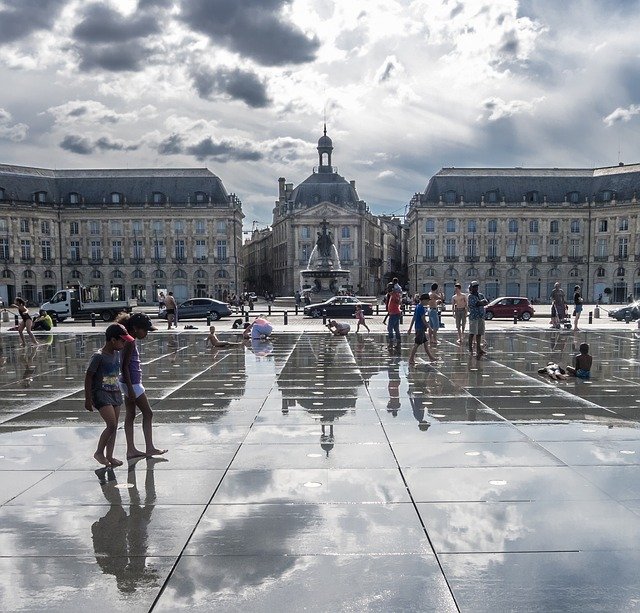Public realm
The term ‘public realm’ is often used loosely, sometimes interchangeably with ‘public domain’, to refer to external urban spaces that are publicly accessible.
According to English Heritage, the public realm ‘…relates to all parts of the built environment where the public has free access. It encompasses: all streets, squares, and other rights of way, whether predominantly in residential, commercial or civic uses...’
DETR defines the public realm as 'Outdoor areas in towns and cities which are accessible to the public' ref The HS2 London-West Midlands Environmental Statement, Glossary of terms and list of abbreviations, 2013.
Bradford City Centre Design Guide, Supplementary Planning Document, published in 2006, defines public realm as: 'The public spaces of an urban area. This includes streets, squares and parks where people are free to walk. It does not include private gardens or courtyards or shopping malls.'
Urban Design Guidelines for Victoria, published by The State of Victoria Department of Environment, Land, Water and Planning in 2017, suggest that: ‘…public realm comprises spaces and places that are open and freely accessible to everyone, regardless of their economic or social conditions. These spaces can include streets, laneways and roads, parks, public plazas, waterways and foreshores.’
The London Plan, published by the Mayor of London in March 2016, defines the public realm as: ‘…the space between and within buildings that is publicly accessible, including streets, squares, forecourts, parks and open spaces.’
High Speed Rail (Crewe – Manchester) Environmental Statement, Glossary, abbreviations and references, published by the Department for Transport in 2022, defines the public realm as: ‘Outdoor areas, other than highways, accessible to the public in towns and cities.’
The term can also be used as a means of describing the physical manifestation of community and of human interaction outside the private home. The ‘everyday spaces’ that are used by people to socialise, play, work, shop, traverse and use for activities such as exercise, enable social processes among residents and citizens.
Whether it is a road between rows of housing, or an urban park, the qualities of the public realm are integral to its use, and this consideration shapes the practice of placemaking.
Placemaking is a term used to describe the process by which an area in the public realm is given a unique and attractive character. For more information see: Placemaking.
NB: Cousseran says that ‘public space is a particular kind of social space created specifically for the bringing together of people, and where locals and strangers, the familiar and the unusual, can mingle freely.’ (Ref. Post-Modern Movement: The Inscribed City, in Urban Design Futures, Alain Cousseran ed Moor, Rowland, Routledge, 2006)
Public domain can also refer to knowledge that is: 'Generally known either by the public at large, or a certain section of it; readily obtainable outside of the organisation.' Ref https://www.cips.org/knowledge/glossary-of-terms/
[edit] Related articles on Designing Buildings
IHBC NewsBlog
Purcell’s guidance on RAAC for Listed Buildings in England & Wales
The guidance specifically focuses on Reinforced Autoclaved Aerated Concrete (RAAC) in listed buildings.
IHBC Membership Journal Context - Latest Issue on 'Hadrian's Wall' Published
The issue includes takes on the wall 'end-to-end' including 'the man who saved it'.
Heritage Building Retrofit Toolkit developed by City of London and Purcell
The toolkit is designed to provide clear and actionable guidance for owners, occupiers and caretakers of historic and listed buildings.
70 countries sign Declaration de Chaillot at Buildings & Climate Global Forum
The declaration is a foundational document enabling progress towards a ‘rapid, fair, and effective transition of the buildings sector’
Bookings open for IHBC Annual School 12-15 June 2024
Theme: Place and Building Care - Finance, Policy and People in Conservation Practice
Rare Sliding Canal Bridge in the UK gets a Major Update
A moveable rail bridge over the Stainforth and Keadby Canal in the Midlands in England has been completely overhauled.
'Restoration and Renewal: Developing the strategic case' Published
The House of Commons Library has published the research briefing, outlining the different options for the Palace of Westminster.
Brum’s Broad Street skyscraper plans approved with unusual rule for residents
A report by a council officer says that the development would provide for a mix of accommodation in a ‘high quality, secure environment...
English Housing Survey 2022 to 2023
Initial findings from the English Housing Survey 2022 to 2023 have been published.
Audit Wales research report: Sustainable development?
A new report from Audit Wales examines how Welsh Councils are supporting repurposing and regeneration of vacant properties and brownfield sites.

















Comments
[edit] To make a comment about this article, click 'Add a comment' above. Separate your comments from any existing comments by inserting a horizontal line.